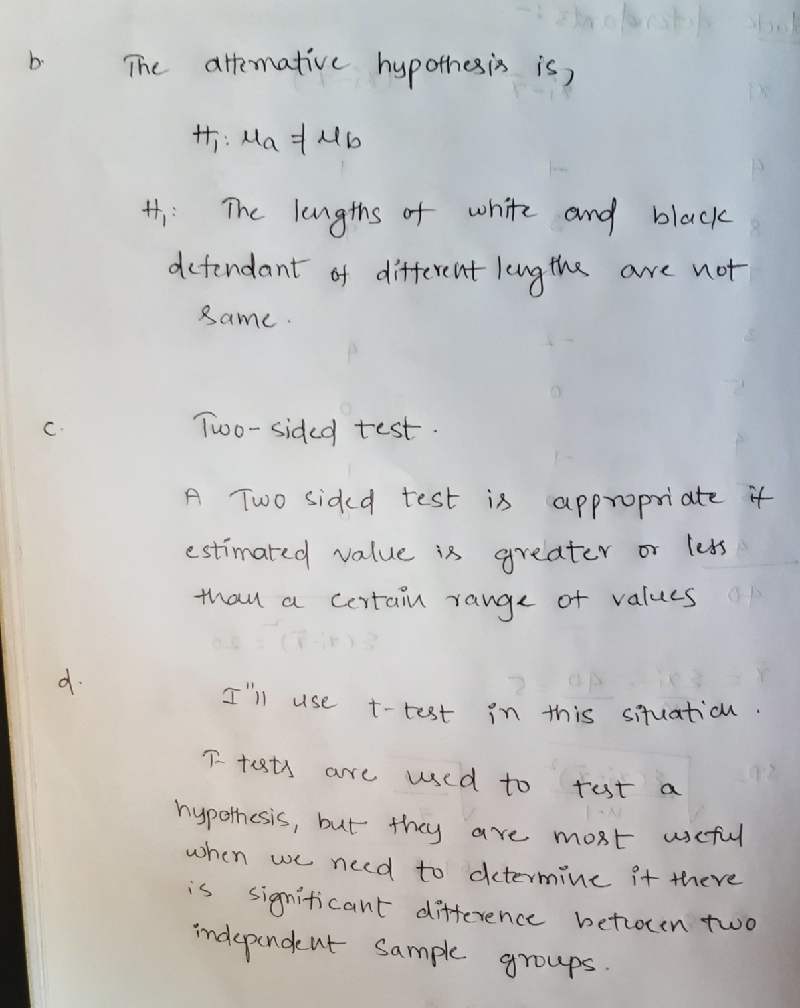Question
In: Statistics and Probability
1. A criminologist is interested in whether there was any disparity in sentencing based on the...
1. A criminologist is interested in whether there was any disparity in sentencing based on the race of the defendant. She selected two random samples of burglary convictions in one jurisdiction and recorded the prison terms given to the 10 white defendants in one sample and the 8 black defendants in the other sample. The sentence lengths (in years) for individuals in the two groups are shown below, along with the sample means and standard deviations. Using these data and a 0.05 alpha level, test the hypothesis that white and black defendants convicted of burglary in this jurisdiction receive prison sentences of different length.
| White Defendants | Black Defendants |
|---|---|
| 3 | 4 |
| 5 | 8 |
| 4 | 7 |
| 7 | 3 |
| 4 | 5 |
| 5 | 4 |
| 6 | 5 |
| 4 | 4 |
| 3 | |
| 2 |
a. In symbols and words, what is the null hypothesis for this test?
b. In symbols and words, what is the alternative hypothesis for this test?
c. Is this a one-sided or two-sided test? How do you know?
d. Will you use a z-test or a t-test in this situation? Why?
e. What is the critical value of the test statistic?
f. What is the value of the test statistic calculated from the sample results?
g. What decision about the null hypothesis does your test lead to?
h. Is the observed racial difference in sentence length statistically significant? Explain.
i. Would your decision be different if you used an alpha level of .01? Explain.
Solutions
Related Solutions
Dr. Roh was interested in whether there was any disparity in sentencing based on the race...
A criminologist is interested in the effects of unemployment and policing on murder and has run...
A criminologist is interested in possible disparities in the length of prison sentences between males and...
As a criminologist, you are interested in the factors related to juvenile offending. You think that...
A researcher is interested in whether or not there is a difference in student’s performance based...
Two college instructors are interested in whether or not there is any variation in the way...
Two college instructors are interested in whether or not there is any variation in the way...
A criminologist conducted a survey to determine whether the incidence of certain types of crime varied...
College students may be interested in whether or not their majors have any effect on starting...
Short Answer 6 You are interested in whether the virus impacts any part of a cell’s...
- Two hockey pucks are moving to the right with puck 1 behind puck 2. Puck 1...
- Imagine that you are in the following real life situation. You are working in the human...
- In the AD-SRAS-LRAS model, what happens to the price level and the unemployment level in the...
- Suggest a policy aimed at encouraging female workforce participation and briefly explain how it might achieve...
- Assume the branch manager is not satisfied with the widths of the obtained confidence intervals, and...
- Using the following equation (Debye-Huckel), find the coefficient of activity of the following: a) Fe3+ with...
- Questions: The densities of ice and water at 0 °C are 0.9168 and 0.9998 g cm–3,respectively....





 Answer
question
Answer
question orchestra answered 3 years ago
orchestra answered 3 years ago